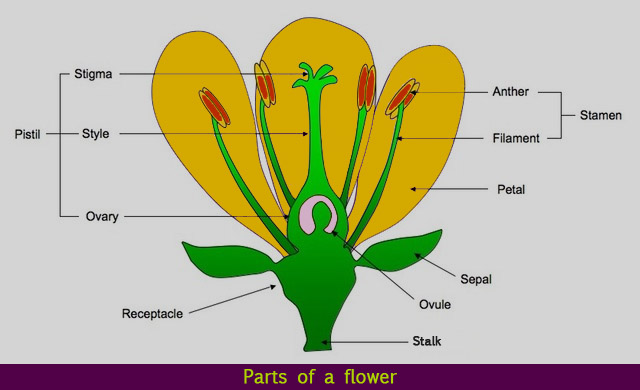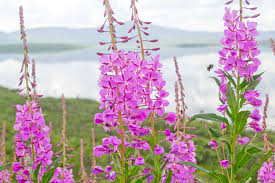The Not So Secret Life of Plants
By Carolyn R. Casey, Fairfax Master Gardener
 Do you really know what your plants are doing in your garden when you are and aren’t looking? You may not be aware that your plants are very busy with each other to reproduce by pollination.
Do you really know what your plants are doing in your garden when you are and aren’t looking? You may not be aware that your plants are very busy with each other to reproduce by pollination.
Pollination is the transfer of pollen grains from the stamens, the flower parts that produce them, to the ovule-bearing organs or to the ovules (seed precursors) themselves. The pollen grains contain one half of the genetic material that is necessary to create a new seed, and the ovule, the egg containing part of the plant, provides the second half of the DNA needed for creation of a viable seed.
There are two kinds of pollination: self-pollination and cross-pollination. Self-pollination occurs when pollen is transferred from the anther to the stigma of a flower on the same plant, and the plant is able to fertilize itself. An egg cell in an ovule of a flower may be fertilized by a sperm cell derived from a pollen grain produced by that same flower or by another flower on the same plant. In either of these two cases, fertilization is said to be due to self-pollination or autogamy. Self-pollination produces offspring with a genetic makeup that is identical to its parent.
Self-pollinated crops, such as beans and peas, have evolved strategies to ensure self-fertilization. Often their flower structure prevents the easy movement of pollen outside the flower, or flowers may be pollinated before they even open. Self-pollination often results in homozygous plant lines, or plants with identical gene pairs for many traits, which guarantee new plants grown from saving seed will be identical to the parent plants. Self-pollinated plants must be spaced a few feet apart to keep the pollen of one plant from pollinating adjacent plants of another variety. With self-pollinating crops, pollen from other plants can pollinate flowers on several plants and decrease varietal purity.
With cross-pollination, the sperm may be derived from pollen originating on a different plant individual (heterogamy). Cross pollination requires a vector commonly known as a pollinator. They can be the wind, water, insects, butterflies, bats and animals that visit the flowers. Both processes are common, but cross-pollination has certain evolutionary advantages for the species: the seeds formed may combine the hereditary traits of both parents, and the resulting offspring generally are more varied than is the case with self-pollination. It produces flowers that are genetically different and creates new species of plants.
Cross-pollination crops, including tomato, watermelon, broccoli, many apple cultivars and cucumber are cross-pollinated by insects, and sweet corn is wind pollinated. In cross-pollination, pollen travels great distances and lands on a different flower of the same species. This leads to genetic diversity and creates unique offspring.

Parts of a flower
Cross-pollination within like crops is not a problem unless you plan to save the seeds for next season’s plantings. When you save and plant seeds from this plant next season you will get varied results. If you want to save your seed then spacing needs to be considered, and spacing needs are different for each crop. Sweet corn requires spacing; otherwise the harvestable crop is affected when it crosses with other varieties of corn. For instance, different corn varieties need to be planted at least 400 yards apart to prevent cross pollination. If pollen from field corn crosses with sweet corn, the sweet corn when harvested will be tough and less sweet than desired. To prevent the crossing of pollen between corn varieties, it helps to plant different varieties of corn at different times so that they don’t all bloom at the same time.
Cross-pollination has no effect on the quality of some harvestable fruit. Depending on the fruit tree, cross pollination is necessary for fruit set. Fruit trees that have overlapping bloom times need to be selected for fruit production. Apple trees that require cross-pollination need at least two varieties that have overlapping bloom times be planted together. Some apple varieties known as self fruitful will have an increased yield and quality when pollinated by another variety.

Exposed ovules on a Sago Palm
In plants such as conifers and cycads, in which the ovules are exposed, the pollen is simply caught in a drop of fluid secreted by the ovule. In flowering plants, however, the ovules are contained within a hollow organ called the pistil, and the pollen is deposited on the pistil’s receptive surface, known as the stigma. There under the right environmental conditions, the pollen germinates and grows a pollen tube, extending down through the pistil toward one of the ovules in its base.
In an act of double fertilization, one of the two sperm cells within the pollen tube fuses with the egg cell of the ovule, making possible the development of an embryo. The other cell combines with the two subsidiary sexual nuclei of the ovule, which initiates formation of a reserve food tissue, the endosperm. The growing ovule then transforms itself into a seed. A prerequisite for fertilization, pollination is necessary for fruit production and seed crops and is essential in the improvement of plant propagation.
Several plants have developed mechanisms that prevent self-pollination. Some date palms (Phoenix dactylifera) and willows (Salix sp.) are dioecious; that is, some plants produce only “male” (staminate) flowers, with the rest producing only “female” (pistillate or ovule-producing) ones. In plants where both staminate and pistillate flowers are found on the same individual (monoecious plants) and in those with hermaphroditic flowers (flowers possessing both stamens and pistils), a frequent way of preventing self-fertilization is to have the pollen shed either before or after the period during which the stigmas on the same plant are receptive, a situation known as dichogamy. The more usual form of dichogamy found especially in such insect-pollinated flowers as fireweed (Epilobium angustifolium) and salvias (Salvia sp.), is protandry, in which the stamens ripen before the pistils. Protogyny, the situation in which the pistils mature first, occurs in arum lilies and many wind-pollinated plants, such as grasses — although several grasses are self-pollinated.

Fireweed, Epilobium angustifolium
A structural feature of flowers that discourages self-pollination is heterostyly, or variation in the length of the style (neck of the pistil). This occurs in the common primrose (Primula vulgaris) and species of wood sorrel (Oxalis) and flax. In some British primroses, about half the plants have so-called “pin” flowers, which possess short stamens and a long style, giving the stigma a position at the flower’s mouth, whereas the other half have “thrum” flowers, in which the style is short and the stamens are long, forming a “thrumhead” at the opening of the flower. Bees can hardly fail to deposit the pollen they receive from one type of flower onto the stigmas of the other type. The genetic system that regulates flower structure in these primroses is so constituted that cross-pollination automatically maintains a 50:50 ratio between pins and thrums. In the flowers of purple loosestrife (Lythrum salicaria), the stamens and styles are of three different lengths to limit self-fertilization.
Hybridizing is the cross-pollination of two plant varieties. It is done manually after a person decides what specific traits and characteristics they want to attempt to produce between two plants. When the pollen is present on the anthers, remove three to four stamens and brush the pollen bearing anthers across the end of the pistil (the stigma). The stigma will be sticky when it is receptive to pollen. To control pollination, remove the flower petals and stamens from the flower being pollinated. The pistil is then pollinated manually and covered with foil to prevent contamination. A fruit will appear and be harvested, and the seeds will be collected and planted. Since hybrids are the result of cross pollination from varieties, the plants may exhibit traits of one or both parent plants or may produce a new variety.
Be mindful of the needs of your plants by purchasing and planting plants that attract pollinators to your garden that improve the pollination process. As you experiment with plants in your garden, it will be interesting to see the outcome of any hybridization particularly among day lilies. Perhaps you may develop a new and more beautiful variety named after your favorite person. Happy Pollinator Gardening!
…updated 2025
- References
- A Hybridizer’s Guide, Walt Elliott, Virginia Polytechnic Institute and State University
- Pollination Basics, University of Maryland Extension
- Cross Pollination Facts, Kenny Bailey, North Carolina Cooperative Extension
- Pollination, Bastiaan J.D. Meeuse, Britannica